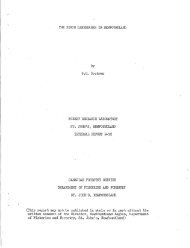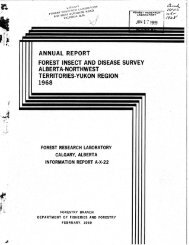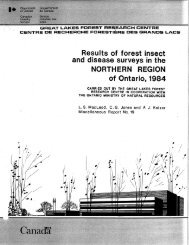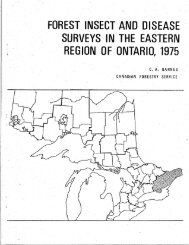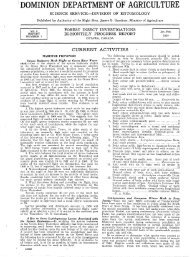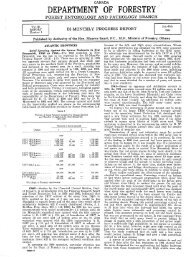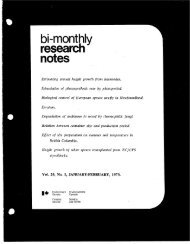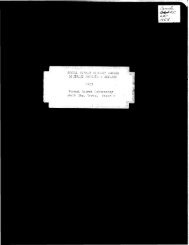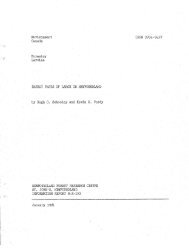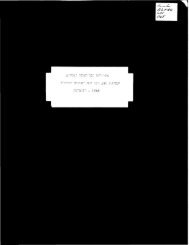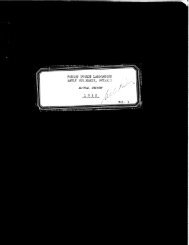Annual District Reports: Forest Insect and Disease Survey ... - NFIS
Annual District Reports: Forest Insect and Disease Survey ... - NFIS
Annual District Reports: Forest Insect and Disease Survey ... - NFIS
You also want an ePaper? Increase the reach of your titles
YUMPU automatically turns print PDFs into web optimized ePapers that Google loves.
-10-<br />
2.1 INTRODUCTION<br />
This report deals with forest insect <strong>and</strong> disease conditions<br />
throughout the Interlake Section <strong>and</strong> the western part of the<br />
Southern <strong>District</strong> of Manitoba extending from the Red River to the<br />
Saskatchewan border. Field surveys were carried out from about mid-May<br />
to October 5, <strong>and</strong> 464 insect <strong>and</strong> 37 disease collections were submitted<br />
to the Winnipeg <strong>and</strong> Saskatoon laboratories respectively. In addition<br />
to general sampling <strong>and</strong> special collections, the following surveyprojects<br />
were continued: forest tent caterpillar egg-b<strong>and</strong> counts to<br />
forecast population <strong>and</strong> infestation trends; larch sawfly cocoon collecting<br />
using the larval-drop tray method to determine the incidence of<br />
parasites <strong>and</strong> disease; sequential sampling of larch sawfly eggs for<br />
population estimates; <strong>and</strong> larval sampling of the boxelder twig borer.<br />
Approximately 3 hours <strong>and</strong> minutes of chartered flying were used for<br />
aerial reconnaisance of inaccessible areas in the Interlake section <strong>and</strong><br />
to map infestations of the forest tent caterpillar, jack-pine budworm<br />
<strong>and</strong> larch sawfly. The cooperation <strong>and</strong> assistance received throughout<br />
the field season from personnel of the Renewable Resources Branch,<br />
Department of Natural Resources is gratefully acknowledged.<br />
The cool, wet weather that prevailed during May <strong>and</strong> June<br />
favored good tree growth, but foliage <strong>and</strong> insect development was delayed<br />
about ten days in most areas. The season ended. with light rainfall <strong>and</strong><br />
much above average temperatures. The larch sawfly was again the most<br />
widely distributed forest insect occurring in outbreak numbers, but populations<br />
generally remained at the same level as in 1962. The jack-pine<br />
budworm infestation along the Gypsumville, Gr<strong>and</strong> Rapids Highway exp<strong>and</strong>ed<br />
<strong>and</strong> increased in intensity, <strong>and</strong> the black-headed budworm was more common<br />
in all areas. Relatively-high larval populations of the yellow-headed.<br />
spruce sawfly caused noticeable defoliation of single or small groups<br />
of trees at widely scattered points,- <strong>and</strong> the infestation of jack-pine<br />
shoot moth, (Eucoma gloriola Hein.) was more widespread. High populations<br />
of adults of the aspen leaf beetle were recorded throughout most<br />
of the <strong>District</strong> in late May <strong>and</strong>. June- However, larval populations did not<br />
develop fully <strong>and</strong> skeletonizing of aspen foliage was patchy <strong>and</strong> less<br />
severe than expected. The status of the forest tent caterpillar remained<br />
unchanged with main infestations again limited to the Lake St. George.<br />
area in the Interlake section. Populations of the aspen blotch miner<br />
were notably higher in many areas but resultant foliage damage was light.<br />
Several localized infestations of, the fall cankerworm developed in parts<br />
of the <strong>District</strong>; defoliation was particularly severe along the Red River<br />
in Metropolitan Winnipeg <strong>and</strong> in field-row plantings in the Lyleton area.<br />
The Most important tree disease condition was continuing<br />
mortality of trembling aspen in prairie "bluffs" in southwestern Manitoba<br />
resulting from the extreme drought of 1961. Spraying with 2 1 4-D for weed<br />
control in field. crops caused notable damage to the shoots <strong>and</strong> foliage<br />
of Manitoba maple <strong>and</strong> several other tree species in localized areas<br />
throughout the agricultural sections, <strong>and</strong> leaf blights of trembling aspen,<br />
balsam poplar <strong>and</strong> white elm caused some coloration <strong>and</strong> early leaf-fall in<br />
some parts of the <strong>District</strong>.



